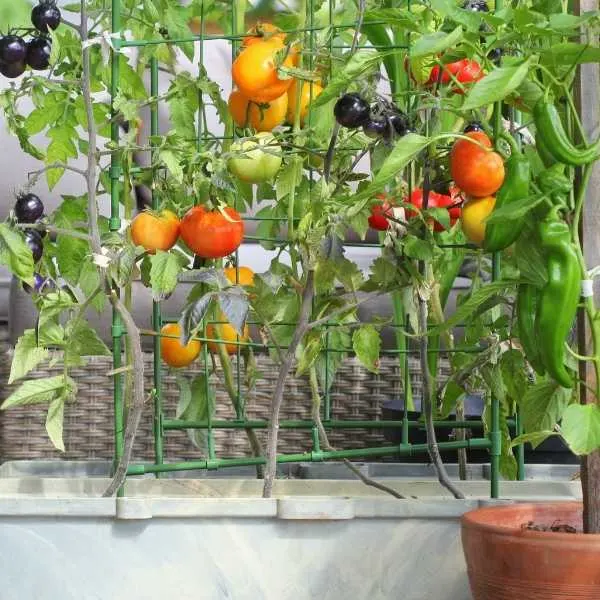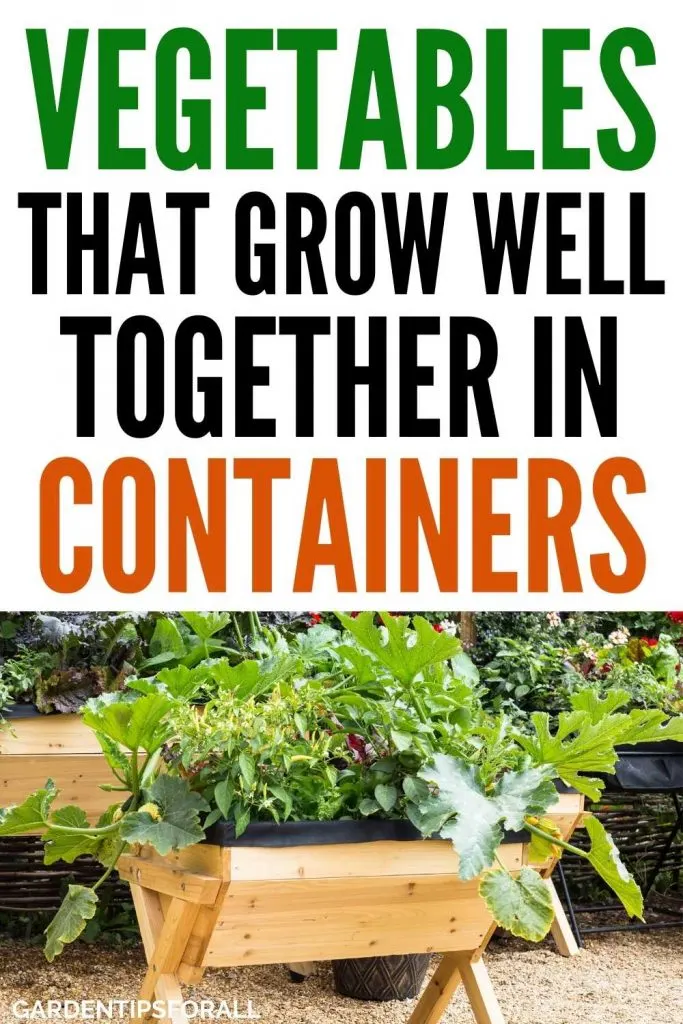What Vegetables Grow Well Together in Containers?
Container gardening is one of the simplest and most convenient forms of gardening, especially for people with small gardens or limited space. This has led a lot of people to ask, what vegetables grow well together in containers?
We are going to answer this question in this article. So keep reading!
Container gardening enables you to grow more plants in a small area, and it’s easier to control pests and diseases in a container garden.
But the best way to maximize the harvests you get from a container garden is to plant different types of vegetables.
This is also known as companion gardening, and it also helps prevent the spread of pests and diseases among plants.
However, not all vegetables can be grown as companions due to differing requirements.

Related Articles:
- Starting a Vegetable Garden from Scratch – Simple Tips and Tricks
- How Many Tomato Plants to Grow in a 4×4 Raised Bed
- What Vegetables can be Grown in 5 Gallon Buckets?
- 10 Best Vegetables for Raised Garden Beds
Factors to Consider When Selecting Vegetable Combinations
Before we go into vegetables that grow well together in containers, here are some of the factors to consider when choosing companion plants.
Growth Habit
It would help if you combined vegetables with different growth habits as this will lead to a rich harvest.
For instance, okra, onions, corn, leeks, and Brussels sprouts will match perfectly with bushy plants like cabbages, carrots, pepper, lettuce, and beans.
Root crops like beets can blend well with a plant that grows above the soil level, like the kohlrabi.
Color
Make your container garden pop by combining plants with colorful leaves and fruits.
For example, you can have striped tomatoes, purple and yellow beans, purple and white eggplants, red lettuce, and red and yellow stalked chard.
Some plants may also have attractive flowers, such as the okra and the squash. You can also sprinkle violas, pinks, nasturtiums, and other edible flowers. You can make any color combination you like, as long as the plants are good companions.
Water and Temperature
Plant vegetables with the same water and temperature requirements to avoid causing strain on any of them. For instance, plant warm weather plants together and cool weather plants together.
Vegetables like onions, beans, and other root crops require constant watering and moisture, whereas vines and tomatoes can dry out for some time and still be fine.
Conversely, vegetables like onions and lettuce prefer shady locations, while others love direct sunlight. If the containers will not be in direct sunlight throughout the day, you can include some of the vegetables that thrive in shaded areas.
Companion Planting
Some combinations are good because the plants complement each other in terms of nutrients and growing conditions. That’s why it’s referred to as companion planting. This way, they are beneficial to each other to boost their growth.
A good combination that has been around for a long time is beans, squash, and corn.
The corn supports pole beans, beans provide nitrogen to the soil, and the squash offers shade to reduce the evaporation rate.
Growing this combination will need an enormous container since corn needs a square pattern of four by four to allow pollination.
Note: Avoid combining legumes and onions, as they will inhibit each other’s growth.
Keep reading to find out the best combinations and the least favorable combinations.
Vegetables that Grow Well in Containers
Before we discuss combinations, below are the vegetables that always grow well in containers:
- Potatoes
- Tomatoes
- Pepper
- Lettuce
- Eggplants
- Herbs
- Carrots
- Summer squash
Vegetables that Grow Well Together in Containers
| Vegetable | Companion (Grow Well Together With) |
| Tomato | Onions, Cucumber, Celery, Carrots, Parsley |
| Onions | Carrots, Swiss chard, Beets, Peppers, Lettuce |
| Carrot | Beans, Tomatoes |
| Celery | Tomatoes, Cabbage, Beans |
| Cabbage, Kale, Brussels sprouts, Broccoli | Potatoes, Onions, Dill, Swiss chard, Spinach, Beets, Lettuce, Celery |
| Potatoes | Melons, Peas, Beans, Cucumber, Pumpkin, Squash |
| Cucumber | Peas, Cabbage, Beans |
| Beets | Cabbage, Broccoli, Kale, Garlic, Lettuce, Onion, Bush beans |
| Eggplant | Pepper, Beans |
| Melon | Radish, Pumpkin, Squash |
| Beans | Radish, Summer savory, Cucumbers, Celery |
| Asparagus | Tomatoes |
| Peas | Radish, Corn, Turnip, Carrot, Cucumber, Beans |
| Squash | Melon, Pumpkin |
NOTE: Plant the vegetables according to the manufacturer’s spacing guidelines and makes sure there’s enough airflow and that they don’t shade each other.
You can also consider including Marigolds in your container garden. They can be combined with most vegetables and help repel pests such as hornworms.
Other herbs that can naturally deter pests include:
- Garlic – aphids
- Chives – aphids
- Rosemary – beetles
- Nasturtium – beetles
- Thyme – cabbage worm
- Oregano – Deters most pests.
What Vegetables Should You Not Plant Together?
Below are some vegetable combinations to avoid:
- Tomatoes, corn, potatoes, kohlrabi
- Beans, garlic, and onions
- Peas, garlic, onions
- Carrots, dill or fennel
- Cabbage family (broccoli, kale, Brussels sprouts, cabbages) with pole beans.
- Beats and pole beans
Benefits of Growing Vegetables Together In Containers

Below are some perks of vegetable container gardening:
#1. Easier for Beginner Gardeners
As a beginner gardener, container gardening is your best shot. This is because you don’t have a lawn to re-seed and patch if your crops fail to thrive. All you have to do is trash the plant and quit or plant something else.
#2. Disease Control
It is easier to treat diseased plants in a container than in a conventional garden. Your diseased plant will not spread to other plants as in a garden.
#3. Less Strenuous
Tending to your container garden is less strenuous, unlike the normal garden. It is easier to customize your container garden’s height so you won’t have to bend so much, thereby saving your back and knees.
#4. Seeds for the Future
It is easier to save seeds for future plants through container gardening.
#5. Portability
There’s the ease of portability when you grow your vegetables in containers. Some plants need different sunlight levels hence the need to take outside or indoors. (You may also want to read this article on Indoor gardening for beginners)
Also, you can bring your outdoors containerized vegetables inside in winter. Besides, if you want to move, you can take your garden with you wherever.
#6. Aesthetics
Potting your vegetables in different containers can enhance the aesthetics of your home. Containers come in different designs, colors, and sizes. You have the liberty to choose containers that reflects your personality.
Moreover, putting your potted vegetables indoors can boost the interior décor of your space.
#7. Protects Your Vegetables
Container gardens are less likely to be under attack from animals like rabbits who love vegetables.
#8. Fun and Kid Friendly
Planting your vegetables in a container is a great way to introduce a new hobby to your kids. It is fun and involves less dirt as compared to lawn gardening.
Also, it will spike their interest to keep a close eye on the growth progress of. To make them feel even more attached, you could try to name the containers by their names or allow them to name them.
This will make them motivated to care for their plants. Besides, planting carrots and tomatoes with your kids will likely make them like eating vegetables.
Factors to Consider When Growing Vegetables in Containers
Below are some things to keep in mind.
Type of Container
Generally, most vegetables are not picky about the type of containers they grow in.
However, you will need a container with proper drainage to avoid infections due to over-watering.
Vegetables in clay pots will need special attention due to the porous nature of clay. Also, clay pots tend to be heavy hence challenging when moving around, especially after planting.
I would suggest you look for a container that is lightweight for easy portability.
Moreover, color is also a determinant as dark colors absorb more heat, making the soil hot for some vegetables.
Size of the Container
Beginners should start with large pots. This is because big containers will hold more soil and moisture that you won’t need to keep watering.
An ideal large pot should measure 10 inches deep and 12 inches wide.
A large container is also ideal for tall plants that need support, like tomatoes and cucumbers.
Also, big containers minimize tipping from trellised plants.
Type of Soil
Preferably, use potting mix, especially for containers that have adequate drainage to allow appropriate moisture levels.
Make sure you fill the container with the potting mix to about 2-3 inches from the rim.
The space you leave just before the rim will give room for deep watering.
Also, ensure you water the soil before planting. You can also add 1 inch of gravel at the bottom for better drainage.
Conclusion
There you have it. There are many vegetables that you can grow together in containers. And as long as you have the space, you can always have several containers with the appropriate companion vegetables. And when they’re all grown, you can use them to prepare tasty meals and kiss goodbye to purchasing vegetables from the grocery store.

References
https://www.bhg.com/gardening/vegetable/vegetables/growing-vegetables-in-containers/
https://modernfarmer.com/2015/06/how-to-grow-fruits-vegetables-and-herbs-in-a-container-garden/
https://homeguides.sfgate.com/fertilize-vegetables-containers-32119.html
https://www.rootwell.com/blogs/vegetable-combinations-grow-containers
